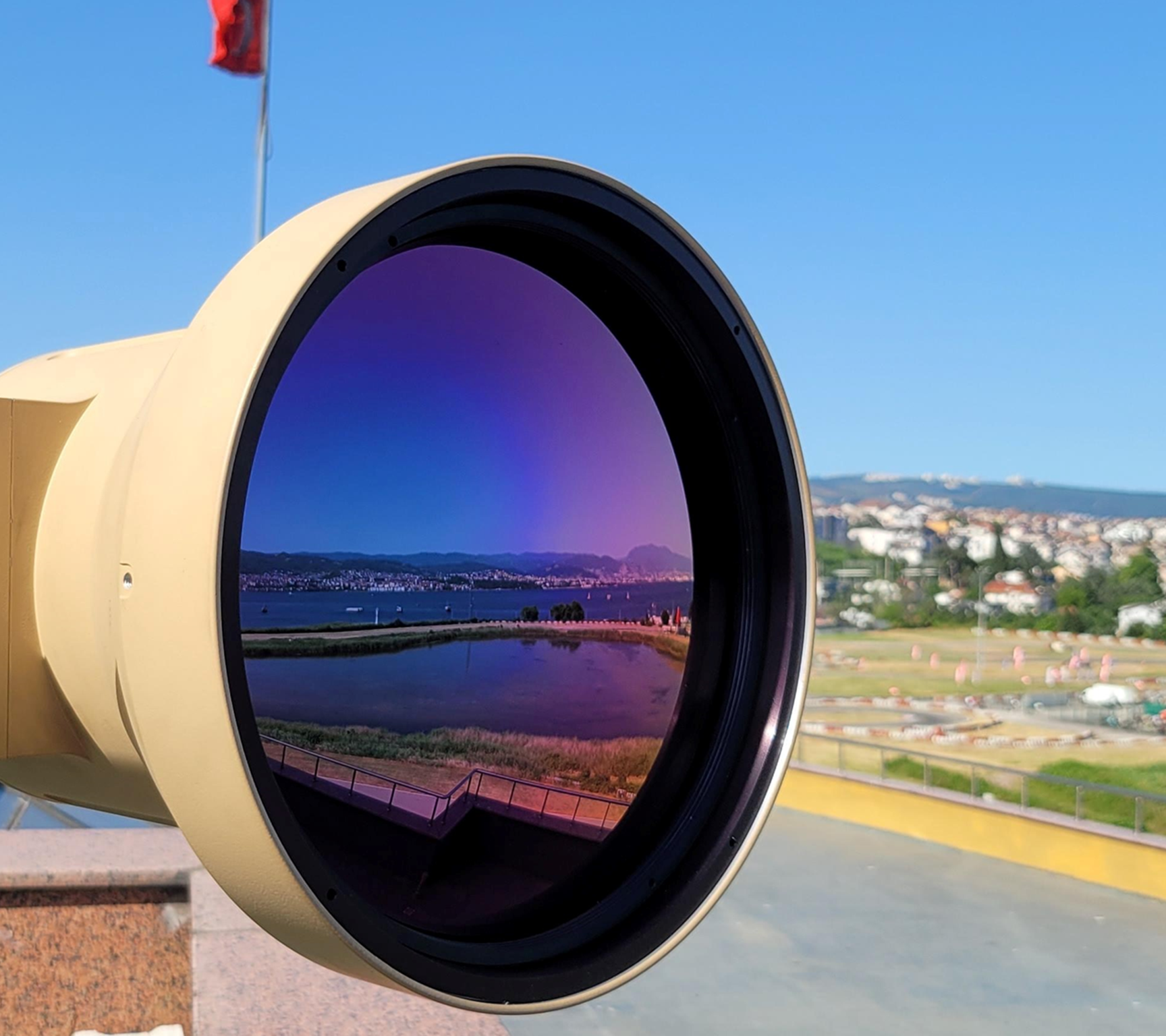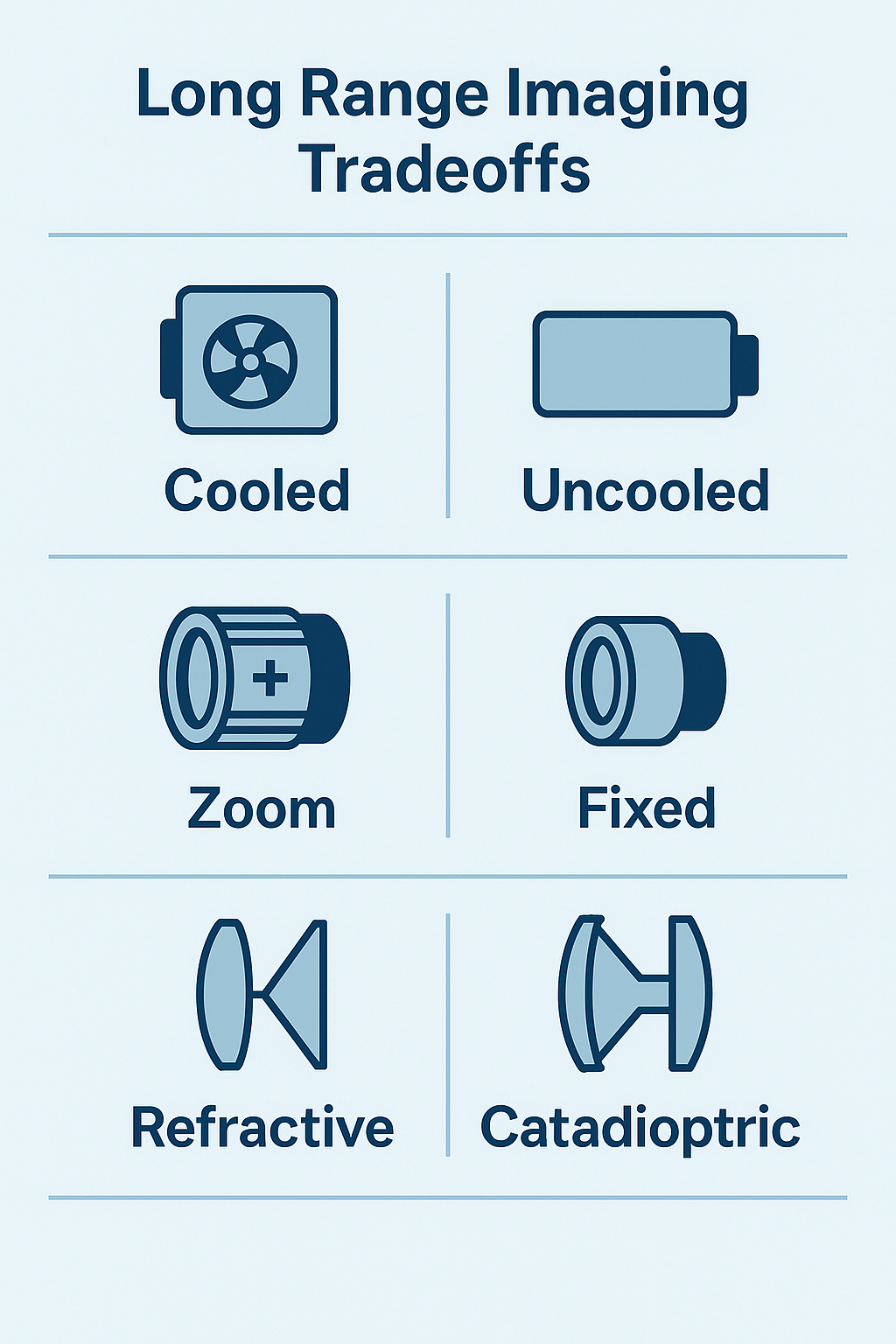
In the modern era of AI-driven systems and persistent surveillance, the long-range thermal imaging camera is the backbone of advanced situational awareness. These cameras deliver image clarity in environments where visible cameras and even the human eye fail—from battlefields, to border security to search and rescue.
But not all thermal imaging cameras are built the same. Each long-range thermal imaging setup reflects a series of hard choices: cooled versus uncooled sensors, zoom versus fixed optics, and refractive versus catadioptric designs. Understanding these tradeoffs is crucial to choosing a thermal imaging solution that delivers on range, clarity, and mission success.

Why Thermal Imaging Cameras Matter
Thermal imaging cameras detect thermal energy emitted by all objects, translating invisible heat into visible images. This enables users to detect humans, vehicles, and objects in total darkness, through fog, smoke, and high temperatures. Unlike visible light cameras, thermal cameras don’t need external illumination, making them ideal for night-time operations, counter-UAS, and fire safety.
Long-range thermal imaging systems offer unmatched detection across large distances. Whether it’s spotting missing persons in rough terrain, protecting critical infrastructure, or monitoring gas leaks in industrial settings, these cameras provide a powerful edge in harsh environments.
Key Components of a Long-Range Thermal Imaging System
A long-range thermal imaging camera combines multiple critical components:
-
Cooled sensors (especially cooled MWIR) provide ultra-sensitive infrared sensor performance, necessary for long distance surveillance.
-
Uncooled LWIR sensors offer simplicity, lower cost, and reduced maintenance—ideal for continuous use.
-
High definition optics with wide angle lens options and large apertures to support long range detection and identification capabilities.
-
Zoom options, from continuous zoom to fixed optics, depending on mission needs. Many fixed optic systems use catadioptric lenses to enable high focal length in compact size.
-
Germanium windows protect the optical system from dust, moisture, and scratches without reducing infrared transmission.
-
Laser rangefinders and laser pointer accessories enhance distance measurement and targeting precision.
-
Pan tilt zoom (PTZ) controls support dynamic tracking and rapid re-targeting, essential for counter-UAS and moving-object scenarios.
-
Video recording, photo shooting, and image recording fast start functions provide real-time and archived mission footage.
Advanced long range thermal imaging cameras also incorporate multi sensor systems that combine thermal with visible light, visible cameras, and radar or laser subsystems to maximize situational awareness.
Designing for Performance and Tradeoffs
The performance of long-range thermal cameras hinges on physical constraints. Larger apertures improve energy collection, but they increase system size and cost. Zoom capabilities add situational awareness but can reduce resolution at range. Engineers must balance these factors based on the operational context.
Cooled MWIR sensors are favored for ultra-long-range detection but require cryogenic cooling and periodic maintenance. InSb detectors offer high sensitivity but operate at 77K, while SLS sensors at 150K allow longer cooler life. Uncooled LWIR systems have lower sensitivity but offer high reliability and lower lifecycle costs.
Pixel pitch and focal length are equally vital. Smaller pixels may improve resolution but gather less thermal energy, reducing signal-to-noise. Larger pixels, like large buckets, capture more heat and improve image quality. This is particularly important in total darkness or foggy environments. While smaller pixels give you higher resolution at the expense of sensitivity. It is a complex dance to develop a solution that meets the mission.

Real-World Applications
Border and perimeter security depend on long range FLIR cameras and long distance surveillance cameras to monitor large swaths of terrain. Telescoping masts and fixed mounts extend line-of-sight while video recording ensures incident documentation.
Military operations and airborne surveillance require military long range surveillance cameras and long range night vision cameras capable of image clarity at extreme distances. These long distance night vision camera systems must withstand shock, vibration, and atmospheric conditions while remaining field-operational.
Search and rescue teams rely on long range thermal imaging cameras to detect human heat signatures in wide-open or cluttered terrain. These missions often involve tower-mounted systems powered by lithium ion or lithium iron phosphate batteries combined with solar panels, offering fast start, extended battery life, and durable performance in the field without reliance on grid power.
Fire operations benefit from the ability to see through smoke, monitor high temperatures, and detect dangerous hotspots. These cameras protect firefighters while improving efficiency.
Industrial inspection, especially in energy or chemical plants, uses thermal imaging to detect gas leaks, overheating components, and protect assets under extreme conditions. Internal electronics must remain stable under variable loads and ambient extremes.
The Clear Align Advantage
At Clear Align, we engineer long range camera systems not just for specs, but for mission outcomes. Our modular platforms enable custom builds without high up-front development costs. You choose what matters: cooled or uncooled, sensor type, zoom level, video format, even housing type. We assemble a tailored solution from proven subsystems.
This modularity ensures fast start, image reliability, and unmatched detection across every range thermal imaging application. Whether you’re guarding a coastline, launching counter-UAS ops, or searching for a missing person, our systems offer the advanced features and important features required for success.
Looking Forward
Thermal imaging will only grow in capability. AI-driven object detection, better optics, and improved sensor sensitivity will redefine what’s possible. Clear Align combines radar, long range thermal, visible, and laser sensing in tighter, lighter, more powerful package.
When your mission depends on seeing what others can't, trust Clear Align to deliver the long range thermal imaging systems that protects, detects, and performs.